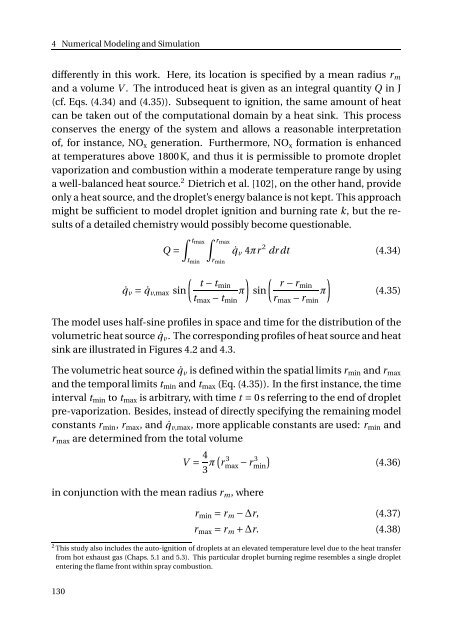On the Formation of Nitrogen Oxides During the Combustion of ...
On the Formation of Nitrogen Oxides During the Combustion of ...
On the Formation of Nitrogen Oxides During the Combustion of ...
Create successful ePaper yourself
Turn your PDF publications into a flip-book with our unique Google optimized e-Paper software.
4 Numerical Modeling and Simulation<br />
differently in this work. Here, its location is specified by a mean radius r m<br />
and a volume V . The introduced heat is given as an integral quantity Q in J<br />
(cf. Eqs. (4.34) and (4.35)). Subsequent to ignition, <strong>the</strong> same amount <strong>of</strong> heat<br />
can be taken out <strong>of</strong> <strong>the</strong> computational domain by a heat sink. This process<br />
conserves <strong>the</strong> energy <strong>of</strong> <strong>the</strong> system and allows a reasonable interpretation<br />
<strong>of</strong>, for instance, NO x generation. Fur<strong>the</strong>rmore, NO x formation is enhanced<br />
at temperatures above 1800 K, and thus it is permissible to promote droplet<br />
vaporization and combustion within a moderate temperature range by using<br />
a well-balanced heat source. 2 Dietrich et al. [102], on <strong>the</strong> o<strong>the</strong>r hand, provide<br />
only a heat source, and <strong>the</strong> droplet’s energy balance is not kept. This approach<br />
might be sufficient to model droplet ignition and burning rate k, but <strong>the</strong> results<br />
<strong>of</strong> a detailed chemistry would possibly become questionable.<br />
Q =<br />
˙q v = ˙q v,max sin<br />
∫ tmax<br />
∫ rmax<br />
t min<br />
r min<br />
˙q v 4πr 2 dr dt (4.34)<br />
( ) ( )<br />
t− tmin<br />
r − rmin<br />
π sin<br />
π<br />
t max − t min r max − r min<br />
(4.35)<br />
The model uses half-sine pr<strong>of</strong>iles in space and time for <strong>the</strong> distribution <strong>of</strong> <strong>the</strong><br />
volumetric heat source ˙q v . The corresponding pr<strong>of</strong>iles <strong>of</strong> heat source and heat<br />
sink are illustrated in Figures 4.2 and 4.3.<br />
The volumetric heat source ˙q v is defined within <strong>the</strong> spatial limits r min and r max<br />
and <strong>the</strong> temporal limits t min and t max (Eq. (4.35)). In <strong>the</strong> first instance, <strong>the</strong> time<br />
interval t min to t max is arbitrary, with time t = 0s referring to <strong>the</strong> end <strong>of</strong> droplet<br />
pre-vaporization. Besides, instead <strong>of</strong> directly specifying <strong>the</strong> remaining model<br />
constants r min , r max , and ˙q v,max , more applicable constants are used: r min and<br />
r max are determined from <strong>the</strong> total volume<br />
V = 4 3 π( r 3 max − r 3 min<br />
)<br />
(4.36)<br />
in conjunction with <strong>the</strong> mean radius r m , where<br />
r min = r m − ∆r, (4.37)<br />
r max = r m + ∆r. (4.38)<br />
2 This study also includes <strong>the</strong> auto-ignition <strong>of</strong> droplets at an elevated temperature level due to <strong>the</strong> heat transfer<br />
from hot exhaust gas (Chaps. 5.1 and 5.3). This particular droplet burning regime resembles a single droplet<br />
entering <strong>the</strong> flame front within spray combustion.<br />
130
















